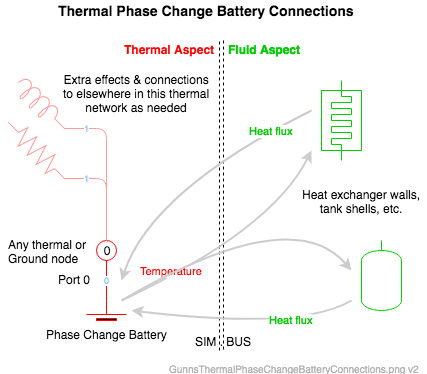GunnsThermalPhaseChangeBattery - nasa/gunns GitHub Wiki

This models a Phase Change Thermal Battery for heat storage. The battery casing contains a mass of material with a significant thermal capacity. This link can model the thermal capacity (as its mass times the specific heat) for two different phases of matter of the material (typically ice & liquid), and the heat of phase change between the phases. The specific heats and heat of phase change are provided as configuration data, so the link can model any kind of material and any two phases. The link labels these phases as "hot" and "cold" since they can be applied to any arbitrary paring of phases. Liquid (hot) and Ice (cold) are the most typical, but you can use any phases.
When all of the phase-change material is in the same phase, either below (cold phase) or above (hot phase) the phase change temperature, this link acts like a regular GunnsThermalCapacitor, applies a capacitance to the Port 0 node, and heat into or out of the node changes its temperature. However while in mixed-phase, the link switches to a GunnsBasicPotential to constrain the node to the phase change temperature, and any heat into or out of the node goes into phase change.
This is a 1-port link. We do away with the Port 1 in other capacitor-type links since it's never used in the thermal aspect.
There is a leak malfunction for leaking out the hotter phase when it is present. The hotter phase is usually the less viscous and more prone to escape the battery through cracks in the enclosure, etc.
This link can update the node temperature when the network is in DUMMY mode, just like the GunnsThermalCapacitor. It can also keep updating the battery temperature when connected to the network Ground node.
Assumptions & Limitations:
- Internal fluid properties like pressure & thermal expansion are not modeled.
- The phase change temperature is constant.
- The specific heats are constant.
- The entire battery & phase-change medium always has uniform temperature.
Below is an example aspect diagram of the typical model uses.
- The node connnected to Port 0 represents the battery thermal mass.
- These kinds of batteries are most typically used to exchange heat with fluid loops passing through them. That is shown as the sim-bus interface with the fluid heat exchanger shape in the diagram below.
- The link can also exhange heat with other objects elsewhere in the thermal network. This happens automatically and doesn't require a sim-bus interface.

Port Connection Rules (These are limitations on the port connection to nodes that the link enforces in run-time):
- This link can attach to any node in a thermal network. If connected to the network Ground node, the link won't affect the Ground node, but it will still update the internal battery state in response to external fluxes from the sim-bus.
Other Rules (These are extra rules you should always try to follow):
- N/A
Configuration Data Parameters:
- phaseChangeTemperature (default = 0 K, must > 0): This is the temperature at which the phase change occurs. For instance, a liquid/ice water battery would use the freeze/melting point of water at 273.15 K.
- phaseChangeHeat (default = 0 (J/g), must > 0): This is the heat or enthalpy of phase change of the working material. For a liquid/ice water battery, this would be the heat of fusion of water at 333.55 J/g.
- hotPhaseSpecificHeat (default = 0 J/g/K, must > 0): This is the specific heat of the working material in its hot phase. For a liquid/ice water battery, this would be the value for liquid water at 4.22 J/g/K.
- coldPhaseSpecificHeat (default = 0 J/g/K, must > 0): This is the specific heat of the working material in its cold phase. For a liquid/ice water battery, this would be the value for water ice at 2.05 J/g/K.
- structureCapacitance (default = 0 J/K, must > 0): This is the heat capacity of the rest of the battery structure (such as the shell) that isn't the phase-change material. This is similar to the capacitance term in the GunnsThermalCapacitor.
Input Data Parameters:
- mass (default = 0 kg, must > 0): This is the initial mass of the phase-change material. We consider this "input data" since it can change in run-time from the hot-phase leak malfunction.
- temperature (default = 0 K, must > 0): This is the initial temperature of the battery and its phase-change mass.
- hotPhaseFraction (default = 0 K, must be (0-1)): This is the initial fraction of the phase-change mass that is in the hotter phase. You only need to specify this value if you want to initialize the battery in mixed-phase. If you set this to > 0 and < 1, then the battery will ignore your initial temperature and instead initialize its temperature to the phase-change temperature.
- malfHotPhaseLeakFlag (default = false): This is the initial state of the hot-phase leak malfunction.
- malfHotPhaseLeakRate (default = 0 kg/s, must >= 0): This is the initial leak rate of the hot-phase leak malfunction. This only leaks the hot-phase mass when it is available. If the battery mass is entirely cold-phase, i.e. hotPhaseFraction = 0.0, then this malf has no effect. Heating the battery up to the phase-change temperature will then start to leak mass out, as the heat going into phase change feeds the leak with hot-phase mass.
- N/A
- N/A